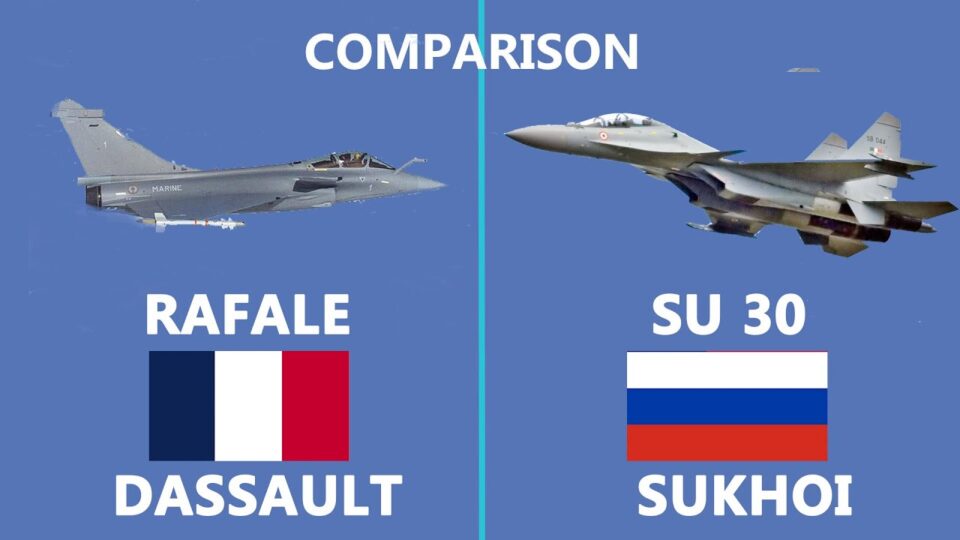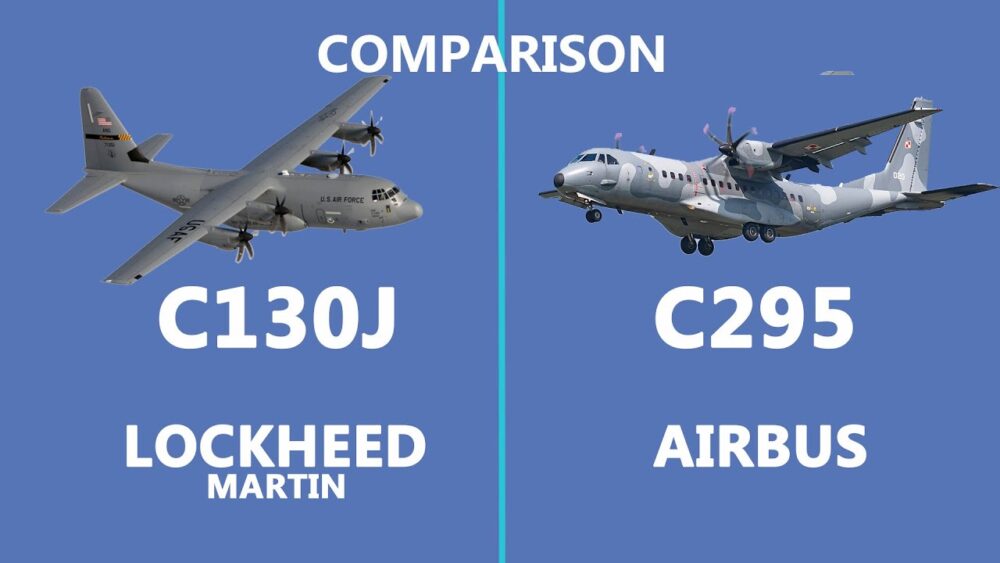Aircraft comparison
Comparison of Russian Su30 and France built Rafale fighter jet

The Su-30 and Rafale are two prominent multirole fighter aircraft that have garnered significant attention in the global defense community. The Su-30, developed by Russia’s Sukhoi, is renowned for its versatility and advanced avionics, while the Rafale, produced by France’s Dassault Aviation, is celebrated for its agility and cutting-edge technology.
In this article, we will compare both fighters, examining their design, technological advancements, and operational capabilities to understand how they stack up against each other in the competitive landscape of modern aerial warfare.
The Sukhoi Su-30 is a Russian fighter jet with two engines and seats for two pilots. It’s designed to fly in all weather and perform air-to-air and ground attacks. It can fly with autopilot and use radar to navigate at low altitudes. The Su-30 can attack both air and ground targets alone or in groups. As of 2024, about 600 of these jets have been built.
The Rafale, is highly versatile, boasting advanced avionics and a wide array of weapons capability. Its design prioritizes agility and adaptability, making it effective in various combat scenarios. As of 2023, approximately 259 Rafale jets have been built, showcasing its significant role in modern air warfare.
Both the Su-30 and Rafale are advanced multirole fighters, each with unique capabilities and design philosophies.
Length:
- The Su-30 measures 21.935 meters (72 feet ) in length, whereas the Rafale is shorter at 15.27 meters (50 feet).
Wingspan:
- The Su-30 has a wingspan of 14.7 meters (48 feet), which is notably wider compared to the Rafale’s wingspan of 10.90 meters (35 feet ).
- Max Takeoff Weight:
- The Su-30’s maximum takeoff weight is 34,500 kilograms (76,059 pounds), significantly higher than the Rafale’s maximum takeoff weight of 24,500 kilograms (54,013 pounds).
- Powerplant:
- The Su-30 is powered by two Saturn AL-31FL/FP turbofan engines, each providing 74.5 kN (16,700 lbf) thrust dry and 122.58 kN (27,560 lbf) with afterburner. In contrast, the Rafale uses two Snecma M88-4e turbofan engines, delivering 50.04 kN (11,250 lbf) thrust dry and 75 kN (17,000 lbf) with afterburner.
- Rate of Climb:
- The Su-30 has a rate of climb of 230 meters per second (45,000 feet per minute), while the Rafale boasts a superior rate of climb at 304.8 meters per second (60,000 feet per minute).
- Maximum Speed:
The Su-30 can reach speeds of up to 2,120 km/h (1,320 mph, Mach 2) at high altitude, while the Rafale has a maximum speed of 1,912 km/h (1,188 mph, Mach 1.8). - The Su-30 has a service ceiling of 17,300 meters (56,800 feet), exceeding the Rafale’s service ceiling of 15,835 meters (51,952 feet).
The Su-30 is renowned for its robust airframe, exceptional maneuverability in all axes, and its iconic “cobra” maneuver. The tactical effectiveness of the cobra maneuver has been a topic of debate for decades, with no clarity its practical application. Designed originally for ground-attack roles, the series incorporates features such as canards, thrust-vectoring engines, and a long-range phased-array radar to excel in air-superiority missions.
Meanwhile, the Rafale was meticulously crafted with reduced radar cross-section (RCS) and infrared signature in mind. Modifications from the initial technology demonstrator include tail-fin size reduction, fuselage reshaping, repositioning of engine air inlets beneath the wing, and extensive use of composite materials. Seventy percent of the Rafale’s intake surface area consists of composites, enhancing its stealth capabilities. However, many features aimed at minimizing the Rafale’s visibility to threats remain classified.
In terms of armament versatility, the Su-30 is equipped with a robust store management system that allows for the integration of a wide range of weapons and equipment. The Su-30 features 12 hardpoints for mounting various ordnance, including air-to-air missiles, air-to-ground missiles, and bombs. Additionally, it is armed with a 30 mm GSh-30-1 cannon, and it can be armed with a diverse array of weapons such as the R-27 and R-77 air-to-air missiles, precision-guided munitions, and various types of bombs.
While the Rafale utilizes a store management system compliant with MIL-STD-1760, facilitating seamless integration of various weapons and equipment. With 14 hardpoints (13 on the Rafale M version), including five suitable for heavy armaments or auxiliary fuel tanks, the rafale vs su 35 Rafale boasts a maximum external load capacity of nine tons. Additionally, it is armed with the 30 mm GIAT 30 revolver cannon and can be configured with an array of laser-guided bombs and ground-attack munitions.

Aircraft comparison
Comparison of the C130J vs C295 cargo aircraft

The Airbus C295 and Lockheed Martin C-130J are two of the most versatile military transport aircraft, each known for its unique strengths across various missions.
While both aircraft are highly capable in transporting troops, cargo, and performing specialized missions, they cater to different operational needs based on their size, capacity, range, and adaptability.
In this comparison, we will delve into the specifications, performance, and operational advantages of the C295 and C-130J, providing insights to help evaluate their suitability for modern military and logistical challenges.
Air India Might Operate Tata-Made New Airbus C295 Aircraft
The Airbus C295 is designed with a focus on short take-off and landing (STOL) capabilities, making it highly effective for regional and remote area transport. This STOL ability allows it to operate from shorter, less-prepared runways, ideal for accessing challenging locations.
In contrast, the Lockheed Martin C-130J prioritizes a larger payload capacity and greater range, enabling it to carry more cargo over longer distances, which is essential for strategic operations. This extended range and load capability make the C-130J well-suited for larger, more demanding missions requiring heavy transport and extended reach.
Here is the Specification of both aircraft.
Length: The Airbus C-295 measures 24.46 meters (80 feet 3 inches) in length, while the Lockheed Martin C-130J is significantly longer at 29.79 meters (97 feet 9 inches).
Max Takeoff Weight: The C-295 has a maximum takeoff weight of 21,000 kg (46,297 lb) for normal operations and 23,200 kg (51,147 lb) for overload. In contrast, the C-130J has a significantly higher maximum takeoff weight of 70,307 kg (155,000 lb).
Fuel Capacity: The C-295 has a fuel capacity of 7,650 liters (2,020 US gallons) and offers an optional in-flight refueling probe. The C-130J, while specific capacity details are not listed, can carry larger amounts of fuel to support its extended range.
Powerplant: The C-295 is powered by two Pratt & Whitney Canada PW127G turboprop engines, providing 1,972 kW (2,644 hp) each, while the C-130J features four Rolls-Royce AE 2100D3 turboprop engines, delivering 3,458 kW (4,637 shp) each.
Range: The C-295 has a normal payload range of 1,555 km (966 miles), whereas the C-130J boasts a maximum range of 3,300 km (2,100 miles) with a normal payload of 15,422 kg (34,000 lb).
Hardpoints: The C-295 features six hardpoints for carrying additional payloads, with a maximum capacity of 800 kg (1,764 lb) on inboard pylons. The C-130J is equipped with six wing hardpoints that allow it to carry extra fuel tanks, sensors, and a variety of weapons, making it more versatile for both cargo and combat roles.
Propellers: The C-295 uses six-bladed Hamilton Sundstrand HS-568F-5 composite propellers, while the C-130J is equipped with six-bladed Dowty R391 composite constant-speed propellers that feature fully feathering and reversible pitch capabilities.
The C295 is equipped with advanced avionics and navigation systems, including a digital cockpit with modern displays and controls, and an integrated mission system for surveillance and communication tasks.
The C-130J Hercules is equipped with advanced avionics and navigation systems as well. It features a modern glass cockpit with digital displays and controls, enhancing situational awareness for the crew. The aircraft includes an integrated mission system that supports various tasks, such as aerial refueling, cargo management, and tactical operations. Additionally, its advanced communication systems ensure reliable connectivity during missions, making it effective for both military and humanitarian operations.
Airbus Final Assembly Line Adapts for A350 Freighter Production
Recently, Airbus inaugurated a Final Assembly Line (FAL) for the C295 aircraft in Vadodara, Gujarat, as part of the ‘Make in India’ initiative. This project aims to deliver 56 C295 aircraft to the Indian Air Force (IAF), with 40 units being manufactured locally and 16 delivered from Spain. So far, six aircraft have already been delivered.
Meanwhile, Lockheed Martin has partnered with Tata Advanced Systems to strengthen support for India’s C-130J Super Hercules fleet. This collaboration aims to set up a Maintenance, Repair, and Overhaul (MRO) hub in India and increase local production of C-130J units, pending approval from the US and Indian governments.
The C-295 has been acquired by several countries, including India, Spain, Egypt, Poland, Canada, Brazil, Mexico, and Portugal, with a total of 225 units built. In comparison, as of March 2022, 500 C-130J aircraft have been delivered to 26 operators across 22 countries.
-

 Aviation2 months ago
Aviation2 months agoMicrosoft Flight Simulator Raises $3 Million to Bring Back the An-225 Mriya
-

 Airlines2 months ago
Airlines2 months agoQatar Citizens Can Travel to the United States Without a Visa
-

 Aviation2 months ago
Aviation2 months agoQatar Airways bans these new Electronic Devices on plane
-

 Defence2 months ago
Defence2 months agoWhich Country Has the Largest Fleet of Fighter Aircraft?
-

 Airlines1 week ago
Airlines1 week agoDAMAC Air: Dubai’s New Luxury Airline Offers Free Flights for Registration
-

 Airport2 months ago
Airport2 months agoWestern Sydney Airport Welcomes Its First Plane After 6 Years of construction
-

 Airlines6 days ago
Airlines6 days agoAir India to Launch aircraft maintenance training institute in Bengaluru
-

 Aviation2 months ago
Aviation2 months agoDid you know ? Once Boeing 747 carried 1088 passenger in 1991








